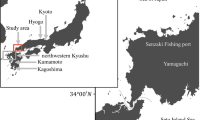Abstract
Biologists have criticized traditional biomass models in fishery economics for being oversimplified. Biological stock assessment models are more sophisticated with regard to biological content, but rarely account for economic objectives. This study includes a full age-structured population model for studying schooling fisheries and extends the delayed difference approach used in earlier studies. We take the total harvest as the choice variable, resulting in a simple analytical structure. The model produces optimal steady states that may be higher or lower compared to the delayed-difference formulation. The model is applied to the Baltic sprat fishery. Both ecological and harvesting cost data support specifying Baltic sprat as a schooling fishery. Given nonlinear harvesting costs, the optimal solution is a path toward a steady state with smooth annual harvest and population age structure. Sensitivity analysis shows that the optimal solution is highly dependent on the population level of the sprat’s main predator Baltic cod. A linear cost function and an interest rate below 9 % imply pulse fishing instead of smooth continuous harvesting. Given nonlinear harvesting cost, the optimal steady state yield is rather insensitive to changes in the interest rate. However, under a high cod scenario, interest rates of 10 % or higher implies that no optimal steady state exists.
Similar content being viewed by others
References
Baranov TI (1918) On the question of the biological basis of fisheries. Issledovatel’skie Ikhtiologicheskii Institut Izvestiya 1: 81–128
Beverton RJH, Holt SJ (1957) The dynamics of exploited fish populations. Chapman and Hall, London
Bjørndal T (1988) The optimal management of North Sea herring. J Environ Econ Manag 15: 9–29
Bjorndal T, Brasao A (2006) The East Atlantic bluefin tuna fisheries: stock collapse or recovery?. Marine Resour Econ 21: 193–210
Brunel T (2010) Age-structure-dependent recruitment: a meta-analysis applied to Northeast Atlantic fish stocks. ICES J Marine Sci 67: 1921–1930
Clark CW (1973) Profit maximization and the extinction of animal species. J Political Econ 4: 950–961
Clark CW (1976) A delayed-recruitment model of population dynamics, with an application to baleen whale populations. J Math Biol 3: 381–391
Clark CW (1990) Mathematical bioeconomics. Wiley, New York
Costello C, Polasky S, Solow A (2001) Renewable resource management with environmental protection. Can J Econ 34: 196–211
Diekert FK, Hjermann DØ, Nævdal E, Stenseth NC (2010) Spare the young fish: optimal harvesting policies for North-East Arctic Cod. Environ Resour Econ 47: 455–475
Getz WM, Haight RG (1989) Population harvesting: demographic models for fish, forest and animal resources. Princeton University Press, New Jersey
Gilbert DJ (1988) Use of a simple age-structured bioeconomic model to estimate optimal long-run surpluses. Marine Resour Econ 5: 23–42
Hannesson R (1975) Fishery dynamics: a North Atlantic cod fishery. Can J Econ 8: 151–173
Hilborn R, Walters CJ (1992) Quantitative fisheries stock assessment: choice, dynamics & uncertainty. Kluwer, Dordrecht
Horwood JW (1987) A calculation of optimal fishing mortalities. J Cons Mer 43: 143–155
Horwood JW, Whittle P (1986) IMA. J Math Appl Med Biol 3: 143–155
ICES (2008) Report of the Baltic Fisheries Assessment Working Group (WGBFAS). ICES CM 2008/ ACOM:06, pp 516–576
ICES (2009a) Report of the Baltic Fisheries Assessment Working Group (WGBFAS). ICES CM 2009/ ACOM:07, pp 449–455
ICES (2009b) Report of the ICES advisory committee. ICES Advice 2009, Book 8
ICES (2010) Life-cycle spatial patterns of small pelagic fish in the Northeast Atlantic. ICES cooperative research report 306, p 94
ICES (2011) Report of the Baltic Fisheries Assessment Working Group (WGBFAS). ICES CM 2011/ ACOM:10
Kornilovs G, Sidrevics L, Dippner JW (2001) Fish and zooplankton interaction in the Central Baltic Sea. ICES J Marine Sci 58: 579–588
Köster FW, Möllmann C (2000) Trophodynamis control by clupeid predators on recruitment success in Baltic cod?. ICES J Marine Sci 57: 310–323
Larkin SL, Sylvia G (1999) Intrinsic fish characteristics and intraseason production efficiency: a management-level bioeconomic analysis of a commercial fishery. Am J Agric Econ 81: 29–43
Lassen H (2011) Industrial fisheries in the Baltic Sea. Report prepared for the European Parliament’s Committee on Fisheries, IP/B/PECH/NT/2010-152
Lee DJ, Larkin SL, Adams CM (2000) A bioeconomic analysis of management alternatives for the US North Atlantic swordfish fishery. Marine Resour Econ 15: 77–96
Lewy P, Vinther M (2004) Modelling stochastic age-length-structured multi-species stock dynamics. ICES CM 2004/FF 20, p 43
Plourde GC (1970) A simple model of replenishable resource exploitation. Am Econ Rev 60: 518–522
Producer Prices for Fish (2004–2009) Official statistics of Finland, agriculture, forestry and fishery. www.rktl.fi
Reed W (1980) Optimum age-specific harvesting in a nonlinear population model. Biometrics 36: 579–593
Schaefer MB (1954) Some aspects of the dynamics of populations important to th management of commercial marine fisheries. Bull Inter-Am Trop Tuna Comm 1: 27–56
STECF (2011) The 2011 annual economic report on the European fishing fleet, STECF-11-16. In: Anderson J, Guillen J, Virtanen J (eds) Joint Research Centre, Ispra
Tahvonen O (2009a) Optimal harvesting of age-structured fish populations. Marine Resour Econ 24: 147–169
Tahvonen O (2009b) Economics of harvesting age-structured fish populations. J Environ Econ Manag 58(3): 281–299
Vallin L, Nissling A (2000) Maternal effects on egg size and egg buoyancy of Baltic cod, Gadus morhua implications for stock structure effects on recruitment. Fish Res 49(1): 21–37
Voss R, Köster FW, Schmidt JO, Peck MA, Möllmann C, Kraus G, Stepputtis D, Hinrichsen H-H (2009) Yes, we can—the successful recovery oft he Baltic sprat stock. In: Symposium on rebuilding depleted fish stocks—biology, ecology, social science and management strategies, Warnemünde, Germany, 3–6 November 2009
Walters CJ (1969) A generalized computer simulation model for fish population studies. Trans Am Fish Soc 98: 505–512
Author information
Authors and Affiliations
Corresponding author
Rights and permissions
About this article
Cite this article
Tahvonen, O., Quaas, M.F., Schmidt, J.O. et al. Optimal Harvesting of an Age-Structured Schooling Fishery. Environ Resource Econ 54, 21–39 (2013). https://doi.org/10.1007/s10640-012-9579-x
Accepted:
Published:
Issue Date:
DOI: https://doi.org/10.1007/s10640-012-9579-x
Keywords
- Age-structured models
- Optimal harvesting
- Economic-ecological optimization
- Fishery management
- Multispecies interaction




